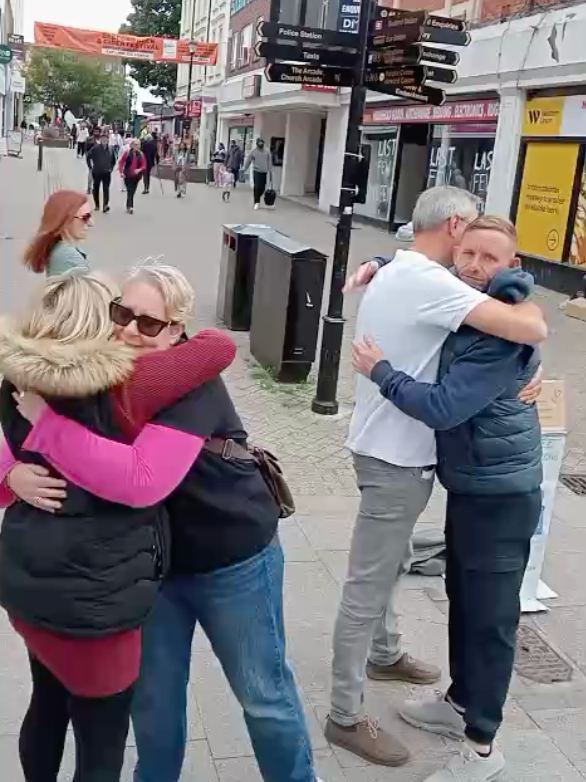Hug It Out: How a Day of Cuddles Became a Masterclass in Connection
- pauseandempower
- Sep 30
- 4 min read
Updated: Oct 3
On a crisp Saturday in Bedford, I spent the day with a stranger hugging other strangers. Not a metaphorical hug, but actual arms-around-shoulders, heart-to-heart hugs.

When I moved here from East London, I realised how much of my support network I’d left behind. I joined local Facebook groups to find my tribe—Guys N Dolls for social events,then came a group for Women Without Kids, a Spiritually Curious Group, and finally, an Embodied Dance Group and there I found Samii Wood, a professional cuddler.
At first, the idea of paying for hugs felt alien. I’d been part of the Burning Man community where “cuddle puddles” were free and frequent. But Samii wasn’t just doling out squeezes. She was “providing healing and connection through Cuddle Therapy & Conscious Connected Touch,” tackling what researchers call “touch hunger”—our society’s growing deficit of safe, positive touch.
Her Hug100 events—aiming for 100 hugs in a day—have been featured on BBC radio, local press and beyond. Bedford isn’t known for its touchy-feely vibe, yet since smashing her first target several months previously, she’s expanded to Brighton and London (Luton and Milton Keynes had to cancel their “hippy hugger” sessions last minute!).
So there I was, standing with Roy (my hugging partner for the day), our Blue Peter-style bollard, and a handful of facts about why a 20-second hug is scientifically magic.
Why Hugs Are More Than Warm Fuzzies
According to Psychology Today (“Four Significant Physical Benefits of Hugging,” van Raalte, 2022), hugs can:
Lower blood pressure and heart rate. Even a brief embrace activates pressure receptors under the skin, signalling the vagus nerve to calm your system.
Boost your immune system. Research shows people who receive more hugs get fewer colds and recover faster.Increase oxytocin. Often called the “bonding hormone,” oxytocin reduces stress and promotes trust.
Reduce cortisol. This stress hormone drops after hugs, leaving you calmer.
The Guardian (26 October 2024) reported new findings from airport studies: hugs lasting 20 seconds or more increased travellers’ sense of connection and reduced anxiety before flights. The article suggested that “longer hugs act like a mini reset for the nervous system.”
And Forbes (Christine Comaford, 2020) echoed the message, noting research from Carnegie Mellon University showing that people who received more hugs during stressful periods had better immune responses and less severe illness.
Armed with these facts, Roy and I stationed ourselves on Bedford Embankment. When footfall proved slow, we moved to the town centre. Samii had already hit her 100-hug target, but that didn’t dampen our spirits.
About ten people committed to the full 20-second hug. In those moments, I could feel their bodies relax. Shoulders dropped, breathing slowed. Even though most hugs lasted around ten seconds, the smiles as people walked away—and even from onlookers—gave me the warm and fuzzies.
Consent Is Cool
I’ve always been tactile—friends used to introduce me as “Amanda, she’s a hugger!” But as awareness of consent has grown, so has my language: “Hi, I’m Amanda, can I give you a cuddle?” Most people say yes. Some don’t. During Hug 100, one dog walking friend even said, “I’m not a hugger. I don’t really like people,” and she wasn’t joking. I respected that—and then hugged her partner for 20 seconds instead.

And here’s an important point: if you’re not a hugger, that’s fine. Dreisoerner et al. (2021) found that even self-soothing touch—like placing your hand over your heart—can lower cortisol. The benefits of gentle, safe touch aren’t reserved only for tactile types. Roy, my hugging partner for the day, started out stiff as a board. But after his first proper 20-second hug, something shifted. He relaxed, smiled, and suddenly there was no stopping him. Hug science in action.
How You Can Use Hug Science at Home
You don’t need to organise a Hug100 event to reap the benefits. Try these evidence-backed tips:
Ask first. “Would you like a hug?” is respectful and disarming.
Aim for 20 seconds. That’s the sweet spot for oxytocin and cortisol reduction (Guardian, 2024).
Create rituals. Morning hugs with your partner, a “welcome home” squeeze with your child, or weekly family cuddle time.
Use self-touch. Place a hand on your heart or hug a cushion to calm your nervous system (Dreisoerner et al., 2021).
Watch posture. Soft shoulders, slower breathing and eye contact signal you’re open to connection.
For midlife women juggling careers, caregiving and hormonal shifts, positive touch can be a simple, free wellbeing boost. It’s one reason coaching conversations often circle back to self-care and connection—because these small practices support resilience.
My Hug100 day wasn’t just about oxytocin. It was about community—real human contact in an era of screens and likes. Safe, consensual touch signals safety, belonging and warmth, all of which are powerful antidotes to stress.
So no, I’m not suggesting you head into town with a sandwich board and start grabbing randoms. But next time you’re with someone you love, consider asking: “Would you like a hug?” You might be giving them (and yourself) a mini health intervention.




Comments